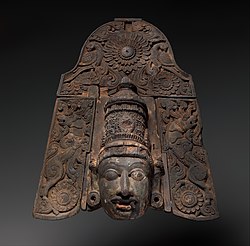Daitya
| Daitya | |
|---|---|
 Sculpture of the daitya king Hiranyakashipu | |
| Affiliation | Asuras |
| Texts | Puranas |
| Parents | Kashyapa and Diti |
The daityas (Sanskrit: दैत्य) are a race of asuras in Hindu mythology, descending from Kashyapa and his wife, Diti.[1] Prominent members of this race include Hiranyaksha, Hiranyakashipu, and Mahabali, all of whom overran the earth, and required three of Vishnu's avataras to be vanquished.[2]
Literature[edit]

The Manusmṛiti classifies the daityas as good, while placing them at a lower level than the devas:
Tāpasā yatayo viprā ye ca vaimānikā gaṇāḥ Nakṣatrāṇi ca daityāśca prathamā sāttvikī gatiḥ
Ascetics and hermits, Brāhmaṇas, celestial beings,[note 1] lunar asterisms, and Daityas represent the first state partaking of ‘Sattva.’
— Manusmṛti 12.48[3]
The origin and noteworthy members of this race are specified in the Harivamsha Purana:[4]
Kashyapa, the well-dressed son of Marichi, espoused two sisters of Prajapati, Diti and Aditi. The great Kashyapa begat on Aditi the twelve classes of the celestials, Dhata, Aryama, Mitra, Varuna, Amsha, Bhaga, Indra, Vivashvan, Pusha, Parjanya, Twastha and Vishnu. He began on Diti the powerful Hiranyakashipu. The Daitya-chief Hiranyaksha was his younger brother. Hiranyakashipu had five highly powerful sons, namely Pralhada, Hlada, Sangrada, Jambha and Anuhrada. Pralhada’s son was Virocana whose son was Bali. Their sons and grand-sons were all very powerful. Thousands of the descendants of these highly powerful daityas are seen all over the land. Having seen Hiranyakashipu slain by the Man-lion the Daityas made Bali their chief for the destruction of the gods. He was heroic, powerful, pious and self-controlled like Hiranyakashipu and therefore was installed as their king by the Daityas.
— Harivamsha, Chapter 40
| Part of a series on |
| Hinduism |
|---|
 |
List of daityas[edit]

Some of the notable daityas mentioned in Hindu mythology include:
- Hiraṇyakaśipu - First son of Kashyapa and Diti
- Hiraṇyākṣa - Second son of Kashyapa and Diti
- Holikā - First daughter of Kashyapa and Diti
- Andhakāsura - Son of Hiraṇyākṣa (Born from the sweat of Śiva)
- Prahlāda - Son of Hiraṇyakaśipu
- Virocana - Son of Prahlāda, father of Mahābalī
- Devamba - Mother of Mahābalī
- Mahābalī - Son of Virocana
- Bāṇāsura - Son of Mahābalī
- Uṣā - Daughter of Bāṇāsura
- Rāhu and Ketu - Head and Body of Svarbhānu, sons of Holikā
- Vajrāṅga - Son of Kashyapa and Diti
- Tārakāsura - Son of Vajrāṅga
- Tripurasura - Son of Tārakāsura
- Shambasura
See also[edit]
References[edit]
- ^ www.wisdomlib.org (23 August 2019). "The army of Demons (Asuras) [Chapter 40]". www.wisdomlib.org. Retrieved 4 August 2022.
- ^ www.wisdomlib.org (28 January 2019). "Story of Diti". www.wisdomlib.org. Retrieved 4 August 2022.
- ^ Jha, Ganganatha (1920). Manusmriti with the Commentary of Medhatithi. ISBN 8120811550.
- ^ www.wisdomlib.org (14 November 2020). "The Beginning of the Dwarf Incarnation: Bali Becomes King [Chapter 40]". www.wisdomlib.org. Retrieved 4 August 2022.
Notes[edit]
External links[edit]
- . New International Encyclopedia. 1905.

